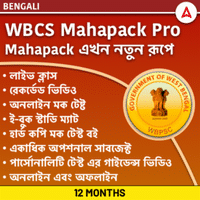ভূগোল MCQ: Adda 247-এ আপনাকে স্বাগতম। ADDA 247 বাংলা আপনাকে WBCS, WBSSC, WBP, WBPSC, RAIL,SSC এবং BANK সহ সমস্ত প্রতিযোগিতামূলক পরীক্ষার জন্য বাংলায় ভূগোল MCQ দিচ্ছে। এখানে আপনি প্রতিদিন সমাধান সহ একাধিক পছন্দের প্রশ্ন এবং উত্তর পাবেন। এখানে আপনি সমস্ত গুরুত্বপূর্ণ প্রশ্ন এবং উত্তর পাবেন যা আপনাকে আপনার জ্ঞান বাড়াতে এবং আপনাকে আপনার লক্ষ্য পূরণের দিকে এগিয়ে যেতে সাহায্য করবে। এই ভূগোল MCQ নিয়মিত পড়ুন এবং পরীক্ষায় সফল হন।
| ভূগোল MCQ | |
| বিষয় | ভূগোল MCQ |
| বিভাগ | Daily Quiz |
| উদ্দেশ্য | WBCS পরীক্ষা |
ভূগোল MCQ
Q1. চা চাষের জন্য অনুকূল আবহাওয়া কি?
- উষ্ণ তাপমাত্রা
- উচ্চ বৃষ্টিপাত
- অধিক উচ্চতা
- ঢালু জমি
(a) 1, 2 এবং 3
(b) 2, 3 এবং 4
(c) 1, 2 এবং 4
(d) চারটিই
Q2. নিম্নলিখিত ফসলের মধ্যে কোনটি অধিকভাবে সাবসিস্টেন্স ফার্মিং এর অধীনে চাষ করা হয়?
(a) বাজরা এবং চাল
(b) তুলা এবং তামাক
(c) চা এবং কফি
(d) শাকসবজি এবং ফল
Q3. ড্যাপোগ পদ্ধতিতে ধানের নার্সারির গড়ে উঠেছে
(a) চীন
(b) ইন্দোনেশিয়া
(c) জাপান
(d) ফিলিপাইন
Q4. কোন ফসল রেড রোট রোগে আক্রান্ত হয়?
(a) চাল
(b) গম
(c) বাজরা
(d) আখ
Q5. ভারতে ফসলের কম ফলনের প্রধান কারণ কি?
- হোল্ডিং ছোট আকার
- চাষের পুরানো পদ্ধতি
- কৃষকদের মধ্যে অধিক নিরক্ষরতা
- নিম্নস্তরের খামার যান্ত্রিকীকরণ
(a) 1, 2 এবং 3
(b) 1, 2 এবং 4
(c) 2, 3 এবং 4
(d) 1, 3 এবং 4
Q6. ফসলের সাথে প্রয়োজনীয় মাটির মিল করুন এবং সেই অনুযায়ী নির্বাচন করুন
সঠিক বিকল্প: ফসলের মাটি প্রয়োজন
(a) চা (i) এঁটেল মাটি সহ পলিমাটি
(b) বাজরা (ii) সুনিষ্কাশিত দোআঁশ মাটি
(c) ধান (iii) কম উর্বর বেলে মাটি
(d) কফি (iv) পলিমাটি যুক্ত পাহাড়ি ঢাল
(a) A – iv, B – iii, C – i, D – ii
(b) A – ii, B – iii, C – iv, D – i
(c) A – ii, B – iv, C – i, D – iii
(d) A – iv, B – ii, C – i, D – iii
Q7. ভারতের লাল মাটি সম্পর্কিত নিম্নলিখিত বিবৃতিগুলির মধ্যে কোনটি সঠিক?
- ফেরিক অক্সাইড উপাদানের কারণে মাটির রঙ লাল
- লাল মাটি চুন, হিউমাস এবং পটাশ সমৃদ্ধ
- তারা ছিদ্রযুক্ত এবং গঠন দুর্বল
নিচের কোডগুলো ব্যবহার করে সঠিক উত্তর নির্বাচন করুন
(a) শুধুমাত্র 1
(b) 1 এবং 3
(c) 2 এবং 3
(d) 1, 2 এবং 3
Q8. 200 সেন্টিমিটারের বেশি বার্ষিক বৃষ্টিপাত এবং ঢালু পাহাড়যুক্ত এলাকার আদর্শ ফসল কোনটি?
(a) পাট
(b) তুলা
(c) ভুট্টা
(d) চা
Q9. কোন মাটিতে সামান্য সেচের প্রয়োজন হয় কারণ এটি মাটির আর্দ্রতা ধরে রাখে?
(a) পলিমাটি
(b) কালো মাটি
(c) লাল মাটি
(d) ল্যাটেরাইট মাটি
Q10. ডবল ক্রপিং যে এলাকাগুলিতে একটি সাধারণ অভ্যাস
- প্রচুর বৃষ্টিপাত
- ভালো সেচের সুবিধা
- একটি দীর্ঘ বৃদ্ধিকাল
- পলিমাটি
(a) 2, 3 এবং 4
(b) 1, 2 এবং 4
(c) 1, 2 এবং 3
(d) 1, 3 এবং 4
ভূগোল MCQ সমাধান
S1. Ans. (c)
Sol. India is the largest producer and exporter of tea in the world. The ideal climatic conditions for the production and growing of tea are as follows: • Temperature: 21°C to 29°C is ideal for the production of tea. High temperature is required in summer. The lowest temperature for the growth of tea is 16°C. • Rainfall: 150-250 cm of rainfall is required for tea cultivation. • Soil: Tea shrubs require fertile mountain soil mixed with lime and iron. The soil should be rich in humus. • Land: Tea cultivation needs well drained land. Stagnation of water is not good for tea plants. Heavy rainfall but no stagnancy of water, such mountain slopes are good for tea cultivation.
S2. Ans. (a)
Sol. Millets and Rice are grown mostly under subsistence farming. Subsistence agriculture is self-sufficiency farming in which the farmers focus on growing enough food to feed themselves and their families. The typical subsistence farm has a range of crops and animals needed by the family to feed and clothe themselves during the year.
S3. Ans. (d)
Sol. Dapog method of rice nursery was developed in Philippines. The dapog method of raising seedling originated in the Philippines and is now, fairly common in South and Southeast. The dapog nursery is constructed for the raising of seedlings without any soil whatsoever. Rice seeds contain sufficient food in the endosperm to permit the young seedling to grow for up to 14 days without receiving any outside nutrients except air, water, and sunlight. Consequently, it is possible to nurse seedlings without actually sowing them in soil.
S4. Ans. (d)
Sol. Red rot disease is caused by fungus and sugarcan is afficted by it.
S5. Ans. (b)
Sol. The low productivity in India is a result of the following factors: • The average size of land holdings is very small (less than 2 hectares) and is subject to fragmentation due to land ceiling acts, and in some cases, family disputes • Adoption of modern agricultural practices and use of technology is inadequate • India has inadequate infrastructure and services. • lliteracy, general socio-economic backwardness, slow progress in implementing land reforms and inadequate or inefficient finance and marketing services. • Inconsistent government policy. • Irrigation facilities are inadequate,
S6. Ans. (a)
Sol. Tea – Hill slopes with alluvial soil Millets – Less fertile and sandy soil Rice – Alluvial soil with clayey sub – soil Coffee – well drained loamy soil.
S7. Ans. (b)
Sol. Red soils are formed by weathering of the ancient crystalline and metamorphic rocks. Their color is red due to their very high iron content. They are found in areas of low rainfall and are obviously less leached than laterite soils. They are sandier and less clayey soils. Red Soil in India is poor in phosphorus, nitrogen and lime contents. The red soil covers a large portion of land in India. It is found in Indian states such as Tamil Nadu, southern Karnataka, north-eastern Andhra Pradesh and some parts of Madhya Pradesh, Chhattisgarh and Odisha.
S8. Ans. (d)
Sol. In an area with annual rainfall of more than 200 cm and sloping hills will be the ideal for tea plantation.
S9. Ans. (b)
Sol. Black soil is formed due to Solid fication of lava spread over large areas during volcanic activity in the deccan plateau. The Soil is rich in iron and nitrogen. It is Suitable for cotton and groundnuts.
S10. Ans. (c)
Sol. In agriculture, multiple cropping is the practice of growing two or more crops in the same piece of land during a single growing season. It is a form of polyculture. It can take the form of doublecropping, in which a second crop is planted after the first has been harvested, or relay cropping, in which the second crop is started amidst the first crop before it has been harvested. A related practice, companion planting, is sometimes used in gardening and intensive cultivation of vegetables and fruits. One example of multi-cropping is tomatoes + onions + marigold; the marigolds repel some tomato pests.




